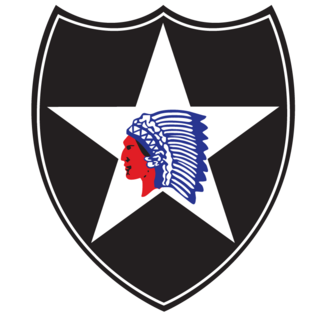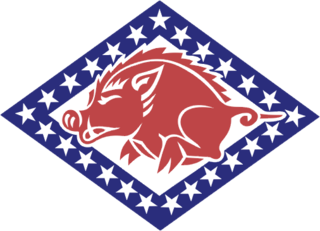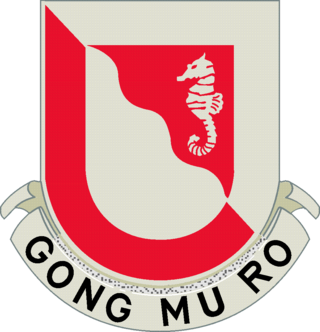
The 3rd Infantry Division (3ID) is a combined arms division of the United States Army based at Fort Stewart, Georgia. It is a subordinate unit of the XVIII Airborne Corps under U.S. Army Forces Command. Its current organization includes a division headquarters and headquarters battalion, two armored brigade combat teams, one aviation brigade, a division artillery, a sustainment brigade and a combat sustainment support battalion along with a maneuver enhancement brigade. The division has a distinguished history, having seen active service in World War I, World War II, the Korean War, and the Global War on Terror. The Medal of Honor has been awarded to 61 members of the 3rd Infantry Division, making the division the most honored in the Army.

The 2nd Infantry Division ("Indianhead") is a formation of the United States Army. Since the 1960s, its primary mission has been the pre-emptive defense of South Korea in the event of an invasion from North Korea. Approximately 17,000 soldiers serve in the 2nd Infantry Division, with 10,000 stationed in South Korea, accounting for about 35% of the United States Forces Korea personnel. Known as the 2nd Infantry Division-ROK/U.S. Combined Division (2ID/RUCD), the division is bolstered by rotational Brigade Combat Teams (BCTs) from other U.S. Army divisions.

The 25th Infantry Division is a United States Army division based at Schofield Barracks in Hawaii. The division, which was activated on 1 October 1941 in Hawaii, conducts military operations primarily in the Asia-Pacific region. Its present deployment is composed of light infantry and aviation units. Tropic Lightning soldiers regularly train with other U.S. military branches to practice and maintain joint operations capabilities. The climate and terrain of the Pacific region demands Tropic Lightning soldiers be able to operate in physically demanding and harsh environments. In 2014, the division opened the Jungle Operations Training Center—the first such school in the Army since the closing of the old Jungle Warfare School at Fort Sherman, Panama Canal Zone. Joint operations and training with partner states herald a new chapter in the history of Tropic Lightning—America's Pacific Division.

The 5th Infantry Division (Mechanized)—nicknamed the "Red Diamond", or the "Red Devils" —was an infantry division of the United States Army that served in World War I, World War II and the Vietnam War, and with NATO and the U.S. Army III Corps. It was deactivated on 24 November 1992 and reflagged as the 2nd Armored Division.

The 44th Infantry Division was a division of the United States Army National Guard from October 1920 to November 1945, when it was inactivated after Federal Service during World War II. A second 44th Infantry Division existed in the Illinois Army National Guard from 1946 until October 1954, when that division was disbanded after federal service during the Korean War.

The 31st Infantry Division ("Dixie") was an infantry division of the United States Army National Guard, active almost continuously from 1917 to 1968. Composed of men from Alabama, Florida, Georgia, Louisiana, Michigan, Illinois, and Mississippi at various points in its existence, the division saw service in both World War I and World War II, and was mobilized during the Korean War, although it was not sent overseas in the latter.

The 28th Infantry Division ("Keystone") is a unit of the United States Army National Guard, and is the oldest division-sized unit in the Army. Some of the units of the division can trace their lineage to Benjamin Franklin's battalion, The Pennsylvania Associators (1747–1777). The division was officially established in 1879 and was later redesignated as the 28th Division in 1917, after the entry of America into the First World War. It is today part of the Pennsylvania Army National Guard, Maryland Army National Guard, Ohio Army National Guard, and New Jersey Army National Guard.

The Arkansas Army National Guard (ARARNG) is a component of the Arkansas National Guard and the United States National Guard. National coordination of various state National Guard units are maintained through the National Guard Bureau.

The 108th Air Defense Artillery Brigade is an air defense artillery brigade of the United States Army. The mission of the brigade is to train and maintain a strategic crisis response air defense artillery brigade capable of deploying worldwide, on short notice, to provide air defense force protection from air-breathing threats and tactical ballistic missiles, as well as allow freedom of maneuver for XVIII Airborne Corps operations.

The 142nd Field Artillery Regiment is a United States Army field artillery regiment currently represented in the Arkansas Army National Guard by the 1st Battalion, 142nd Field Artillery, headquartered in Bentonville, Arkansas; 2nd Battalion, 142nd Field Artillery, headquartered in Barling, Arkansas; and Battery F, 142nd Field Artillery stationed in Fayetteville, Arkansas, elements of the 142nd Field Artillery Brigade which is headquartered in Fayetteville, Arkansas. The regiment was created in 1917 from the former 2nd Arkansas Infantry. The 142nd Field Artillery shipped to France during World War I but did not see combat before the cessation of hostilities. The regiment was activated for World War II, but its battalions were redesignated as separate battalions, 1–142nd became the 936th Field Artillery Battalion, the 2–142nd became the 937th Field Artillery Battalion. The battalion's served throughout the European Theater of Operations. The battalions were activated again for the Korean War and served throughout the war. Following the Korean War, the separate battalions resumed their former designations of 1–142nd FA and 2–142nd FA. The 142nd Field Artillery Brigade, including both battalions, was activated for Operation Desert Storm. Elements of the 142nd Fires Brigade have been activated for service in Operation Noble Eagle and Operation Iraqi Freedom. The 142nd Fires Brigade was instrumental in support and recovery operations located in New Orleans, Louisiana after hurricanes Katrina and Rita devastated the Gulf Coast.

The 12th Field Artillery Regiment is a unit of the United States Army.

The 206th Field Artillery Regiment is a United States artillery regiment, currently represented in the Arkansas Army National Guard by the 1st Battalion, 206th Field Artillery, Headquartered at Russellville, Arkansas. The 1–206th FA is an element of the 39th Infantry Brigade Combat Team.

39th Brigade Support Battalion is an element of the 39th Infantry Brigade Combat Team (IBCT), of the Arkansas Army National Guard. The battalion is headquartered at Hazen, Arkansas. The 39th Support Battalion was constituted on 2 November 1967 from existing units in central Arkansas and assigned to the 39th Infantry Brigade with headquarters in Hazen. Headquarters and Headquarters Battery, 2nd Battalion, 206th Field Artillery Regiment, at Hazen was reorganized and re-designated as the Headquarters and Headquarters Company, 39th Support Battalion.

The history of the Arkansas National Guard and World War II begins with the reorganization following World War I. The State first reorganized a provision unit, the 5th Arkansas, in order to provide a force to deal with domestic situations. As the Defense Department slowly implemented the massive changes and expansions outlined National Defense Act of 1916, the Arkansas National Guard was allowed to reorganize its war time units, including the 153rd Infantry Regiment, the 141st Machine Gun Battalion, and the 142nd Field Artillery. The Guard acquired its first permanent facilities and additional training during its annual encampments. During World War II, the entire Arkansas National Guard was activated and units saw duty in the Pacific and European theaters of conflict.

The history of the Arkansas Army National Guard in Operation Desert Storm begins with the reorganization of the Arkansas Army National Guard following the end of the Cold War. The Arkansas Army National Guard had 13 units called into federal service during Operation Desert Shield/Desert Storm and the Arkansas Air National Guard had members of 10 units called up. More than 3,400 Arkansas Guard soldiers were called up, the second highest percentage of any state or territory. Four Arkansas units were deployed stateside or to Germany, the rest were deployed into the South West Asia Theater of Operations. The largest Arkansas unit deployed was the 142nd Field Artillery Brigade. Arkansas also deployed Medical, Maintenance, Transportation units along with a Rear Area Operations Center.

The 14th Brigade Engineer Battalion is a Combat Engineer Battalion of the United States Army based at Joint Base Lewis-McChord, Washington. The battalion is a subordinate unit of the 2nd Stryker Brigade, 2nd Infantry Division, and I Corps. The battalion's official motto is "Gong Mu Ro" and battle cry "Rugged!".

The 7th Air Defense Artillery Regiment is an air defense artillery regiment of the United States Army, first constituted in the Regular Army as the 7th Regiment of Artillery on 8 March 1898. The 6th and 7th U.S. Artillery Regiments were constituted on 8 March 1898, three weeks after the explosion of USS Maine in Havana, Cuba on 15 February 1898, as the United States' declaration of war on Spain and commencement of the Spanish–American War seemed imminent.

The 2nd Infantry Division Artillery (DIVARTY) or "Warrior Strike" is the Force Field Artillery Headquarters for the 2nd Infantry Division. The DIVARTY served with the division from 1917 to present, including combat service in World War I, World War II, and the Korean War. In addition to peacetime service with the division at Fort Lewis, Washington, Fort Benning, Georgia, and in Japan and Alaska, the DIVARTY spent 40 years in Korea. After seven years stationed at Joint Base Lewis–McChord, where the DIVARTY provided fire support coordination and mission command for the training and readiness of five field artillery battalions, the Army restationed the DIVARTY to Camp Humphreys on 16 September 2021.

The 142nd Field Artillery Brigade is a field artillery brigade in the Arkansas Army National Guard (ARNG). The 142nd is currently under administrative control of the 29th Infantry Division.

I Corps Artillery was a United States Army division-level command active during World War I, World War II, the Korean War and the Cold War. Today the 65th Field Artillery Brigade continues the lineage of I Corps Artillery.























